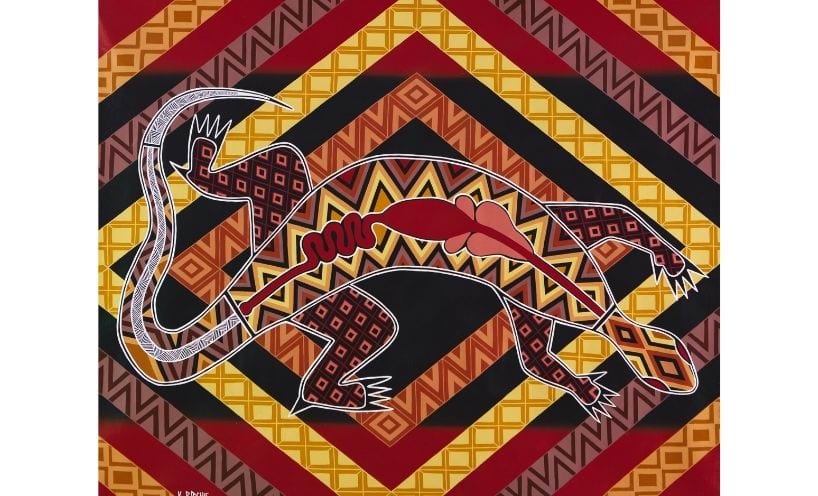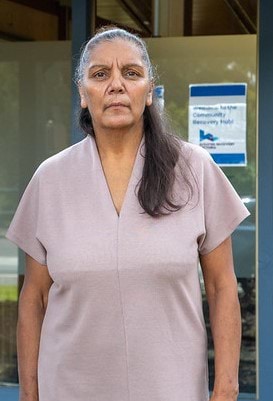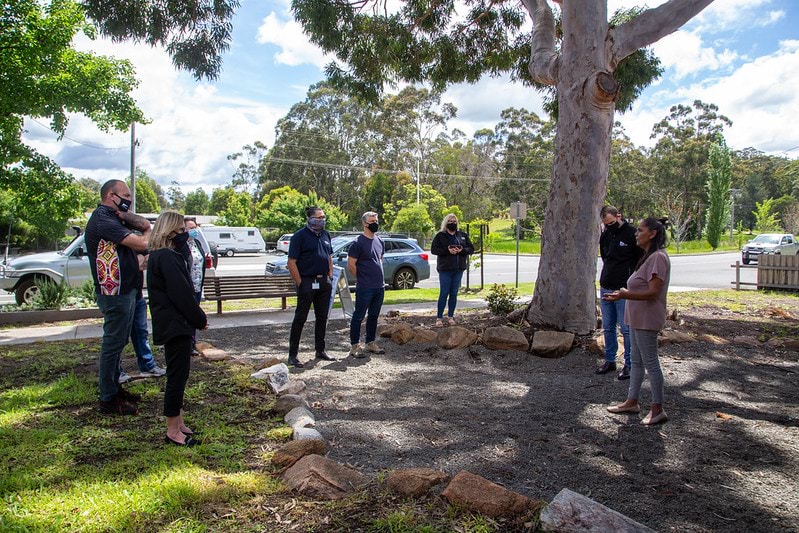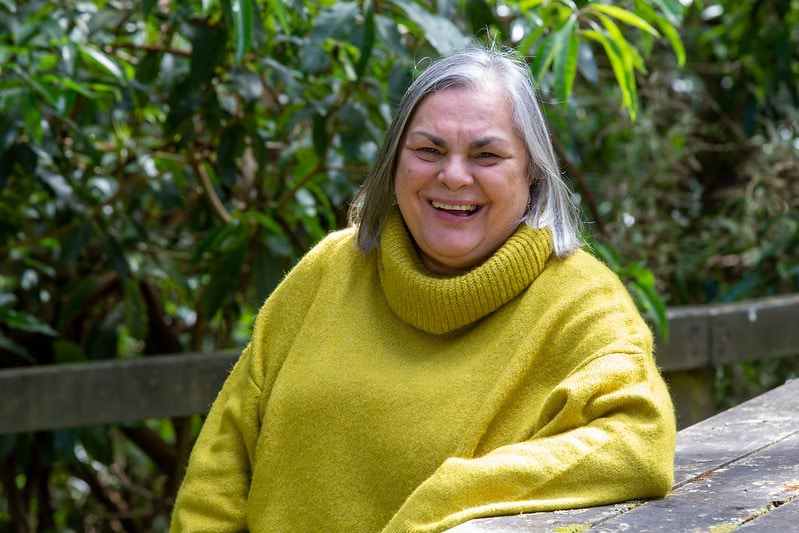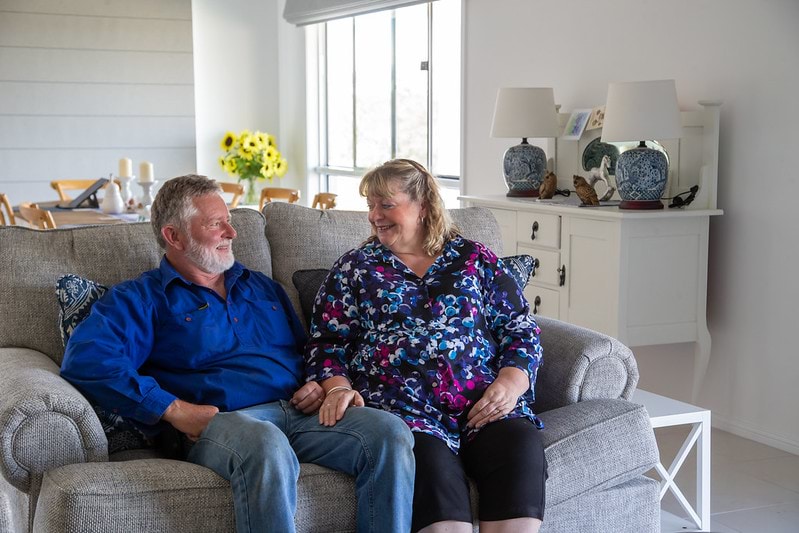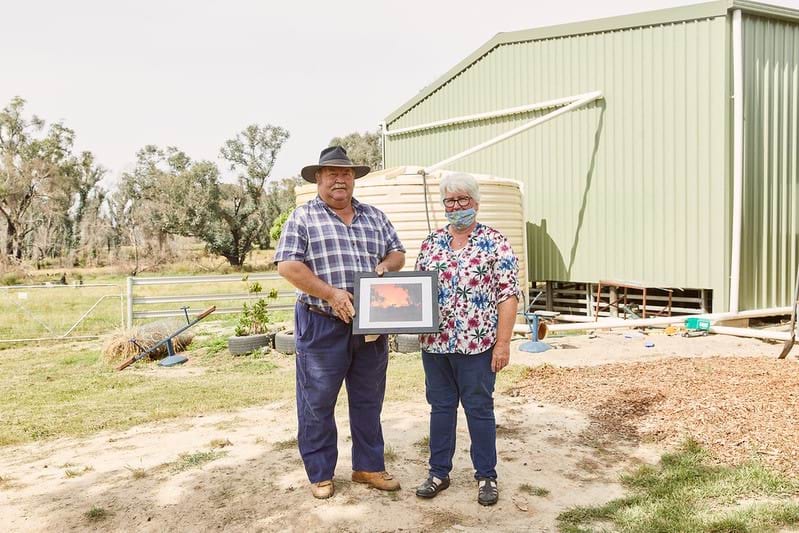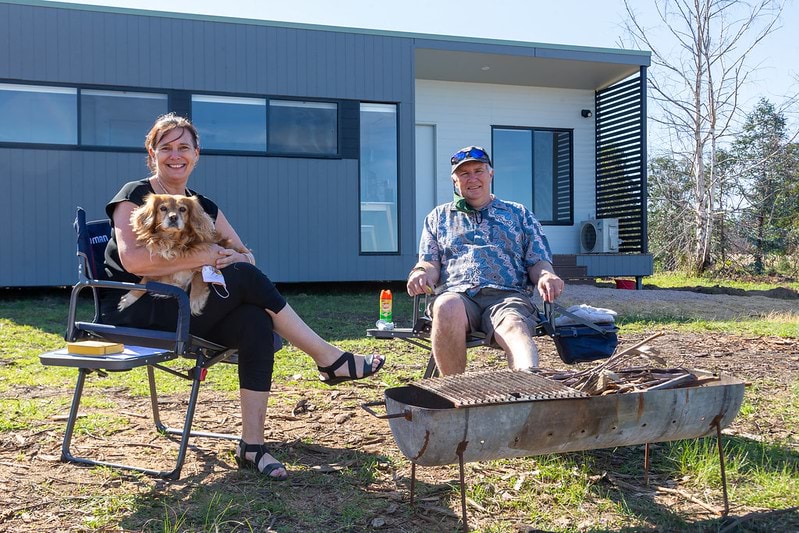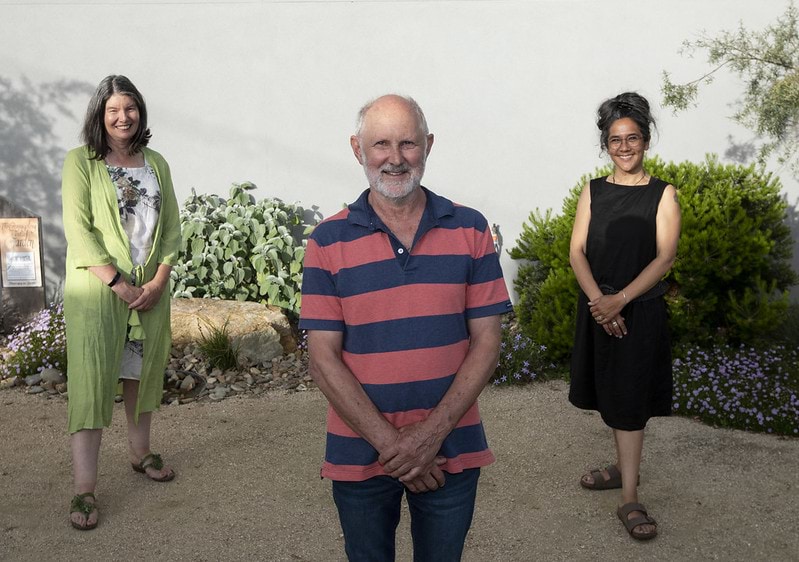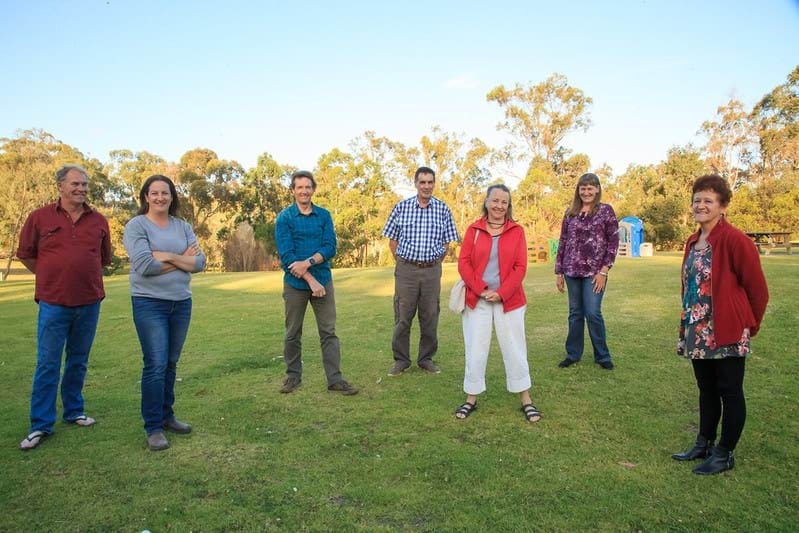- Date:
- 25 Aug 2021
We proudly acknowledge the First Peoples of Victoria and their ongoing strength in practising the world’s oldest living culture. We acknowledge the Traditional Owners of the lands and waters on which we live and work and pay our respects to their Elders past and present.
Pictured: Keith (Gunaikurnai, Monero people) Gunai, Kurnai Bataluk, 2019 Acrylic on canvas
About the artist
Keith is a Gunaikurnai, Monero artist with cultural ties to East Gippsland in Victoria. He started painting 3 years ago and finds painting very calming. When he paints, he feels at ease and more connected to his ancestors. Keith’s paintings are defined by a bold use of colour and the diamond-shaped line work that is a characteristic of south eastern Aboriginal designs. Emergency Recovery Victoria partnered with The Torch to source this artwork and support the artist.
Stories of Recovery – after the 2019–20 Eastern Victorian bushfires
During the fire season last year, communities in East Gippsland and our state’s north-east faced the harshest of conditions. The bushfires that raged across the state were devastating and unrelenting. The trauma of last year’s fire season will not be forgotten. The grief remains even as the rebuilding is underway. Recovering from such a devastating bushfire is never easy, but this crisis was made all the more difficult by an unprecedented global health pandemic.
Over the last year I have consistently been amazed at the way communities have faced adversity and come together to grieve, recover and rebuild.
Local communities have led their own recoveries – identifying their own priorities and making their needs known. Whether it’s additional mental health support, case workers to help navigate the system, grants to start rebuilding community facilities or simply extra dollars in the hands of those who need it most – communities are telling us what they need.
Rebuilding from bushfires is about more than bricks and mortar – it’s about rebuilding livelihoods, businesses and communities. This is a long journey and over a year on, it is by no means over. We will continue to stand should-to-shoulder with communities as they rebuild better and stronger – on their own terms.
Emergency Recovery Victoria (formerly Bushfire Recovery Victoria) was established in October 2022 to be the state’s permanent and dedicated agency helping communities recover from the 2019–20 fires in East Gippsland and the North East, and from future major disaster or emergency events in Victoria (except pandemics).
The first fire ignited in November 2019, the last significant fire was contained in February 2020, and in the year that followed, bushfire-affected communities had to endure a second disaster in the pandemic.
Through it all, the generosity and sacrifice of individuals on the ground has driven a true, community-led recovery, where councils, community recovery committees and other local groups have been empowered to set their own local priorities.
We have undertaken a complex bushfire clean-up, rolled out unique modular housing, provided personal, financial and rebuilding support for individuals in need, and coordinated a recovery across the pillars of wellbeing, economy, the built and natural environments and Aboriginal culture and healing.
The journey is ongoing. There is still work ahead of us. We know from previous fires that bushfire recovery is not a matter of months, but a matter of years, and Emergency Recovery Victoria and the Victorian Government, along with our recovery partners, are standing side-by-side with communities for the long haul.
A message from Dr Rob Gordon
Rob Gordon is a clinical psychologist who has worked in disaster recovery since the Ash Wednesday fires.
'At the beginning of this journey, drawing on what people have told me after other disasters, I made the case to communities that a rushed recovery is not necessarily the right recovery.'
'I’ve encouraged people to take their time and take a moment to prioritise their personal health and wellbeing and protect what they can’t replace while they deal with their losses – because getting one’s life back together is not a sprint.'
'One of the ways that Emergency Recovery Victoria has worked to help people take time with big decisions is the short-term modular housing program. It lets people live in comfort and back in their community for a number of years before they decide whether or not to proceed with a rebuild.'
'The Recovery Support Program has also provided a real, local point of connection to people in need, and made it easier for those who wouldn’t ordinarily reach out for support to take it up.'
'It has continued over time – because the most important factor in any recovery is the decisions people make right now, 6 months to 2 years after a disaster.'
'To bushfire-affected Victorians, I say that no recovery finishes after 12 months. There’s a fair way to go yet. But it will end. This is a phase of your life, not its totality.'
'By finding a sense of community in your local area, with your passions, and with your friends and family – and by taking up the support that you are entitled to and deserve – you will emerge stronger than you know.'
Data presented is as at January 2021 unless otherwise noted. We proudly use local talent to photograph and showcase recovery stories, and we are grateful to Rachael Mounsey, Maree Regan and many others for their work.
Authorised and published by Emergency Recovery Victoria, 121 Exhibition St, Melbourne, 3000.
© State of Victoria, February 2021.
This work is licensed under a Creative Commons Attribution 4.0 international licence.
It is a condition of this licence that you credit the State of Victoria as author.
Aboriginal Culture and Healing
For the first time following a bushfire in Australia, the Victorian Government recognises Aboriginal Culture and Healing as a pillar of recovery with a dedicated focus, alongside the built environment, the natural environment, the economy and wellbeing.
In practice, this means a community-led approach working with Traditional Owners and Aboriginal Community Organisations to prioritise culture, address trauma, support healing, promote cultural safety and transfer power and resources to communities.
The vision, as determined by the community, is to ensure Aboriginal Victorians in fire-affected areas are supported to flourish through the practice of cultural knowledge systems that inform their physical, mental and spiritual health.
Aunty Aileen's Story
Aunty Aileen Blackburn (pictured) is an Elder from Gunaikurnai Country in East Gippsland.
“I am the custodian of the yam. I’m the keeper of the yam. Before them bushfires, I went and harvested some yams. It was not the right time, but something told me I had to. I planted them in pots at home. Them fires came through and burnt all that bush bad. All them yams burnt - this type of yam gone forever. But I have that type of yam. Them yams still in pots growing strong. But I don’t like this. They belong in Country not in pots – so spirit is free. When they forced us off Country, I now know how it must have felt for the old people being pushed off, removed from Country. I have cultural obligations. This will never happen again. I would rather die on Country than not meet my cultural obligations.”
How our people used to live
Taungurung Land and Waters Council CEO Matthew Burns said when bushfire strips the ground cover and the leaf litter, it uncovers a huge number of cultural heritage artefacts.
“After 2009, we found tens and thousands of artefacts strewn across the landscape indicating heavy occupation of Country over as many years. It helps us as Traditional Owners understand how our people used to live.”
Mitigation
Aboriginal infrastructure and housing stock require funding for future bushfire mitigation. ERV’s 2019-20 State Recovery Plan provided $2 million to futureproof Aboriginal infrastructure and housing stock and ensure Aboriginal voices lead bushfire management solutions into the future. The Plan also provided $1.8 million to support Aboriginal Controlled Community Organisations and $1 million for targeted support for Aboriginal businesses and workers.
Aboriginal Community Support
Nindi Ngujarn Ngarigo Monero Aboriginal Corporation was one of eight Aboriginal Community Organisations to receive funding under ERV’s Bushfire Recovery Grants for Aboriginal Communities.
Executive Officer Dr Aunty Doris Paton said they will use the funding to bring people back on Country where they can start healing through a series of camps and training workshops.
During the camps, people will reconnect, learn about cultural knowledge, including cultural mapping, learning language, identifying cultural artefacts and sharing stories about the mob, kinships and connection to the land.
“Nindi Ngujarn has a lot of skilled people and until now, we’ve not been able to really have those skills and that knowledge recognised as a group.”
Other Aboriginal Community Organisations to receive grant funding include:
- Moogji Aboriginal Council East Gippsland Inc
- Lake Tyers Health and Children’s Services
- Lakes Entrance Aboriginal Health Association
- Lake Tyers Aboriginal Trust
- Taungurung Land and Waters Council
- Gunaikurnai Land & Waters Aboriginal Corporation
- Gippsland & East Gippsland Aboriginal Cooperative
Sherryn Antonopoulos of Taungurung Land and Waters Council said about the funding:
“[It] will allow us to move forward with cultural heritage work and biodiversity work...we are grateful and we are really excited and eager to get ourselves, our Elders and our community back on Country.”
The grants were jointly funded by the Australian and Victorian Governments.
People and Wellbeing
Recovery Support Program
The free bushfire recovery support program was established soon after the fires to link individuals and families with someone who can help get things done on their behalf.
Recovery support workers are advocates, problem solvers, and experts on support that’s available They identify critical needs and options for grants. They refer people to important services. They are a constant presence in the lives of people during their recovery.
Recovery support workers are generally locals, employed by community health services and other local agencies. They are experienced in providing trauma-informed outreach and support.
Over the last year, thousands of people have been supported by this program, which is funded by the Australian and Victorian Governments.
Megan and Izaiah's story
After Megan was evacuated from her home in Cabbage Tree Creek, she went to NSW to stay with her 18-year-old son, Izaiah, and his father. When Izaiah and his father’s house was destroyed by bushfires, Izaiah planned to move back to Cabbage Tree Creek to live with Megan.
On their return home in February, they found their bathroom had been destroyed. A Recovery Support Worker from Gippsland and East Gippsland Aboriginal Cooperative (GEGAC), Cathy, supported the family with a GEGAC Appeal Grant to assist with the bathroom repairs.
Izaiah was new to the area and unsure what to do in his bushfire-affected community. GEGAC helped him to access Centrelink’s Youth Allowance and to apply for a Certificate III in Conservation and Land Management. The Case Support worker coordinated funding for his enrolment and provided funding for safety boots and clothing.
Megan and Izaiah are happy with the support they received from Cathy, GEGAC and the Case Support program, not just for their immediate recovery needs, but for providing Izaiah with opportunities for the future.
Stephen's Story
“I learnt on Facebook messenger that my house, and nearly every other on my road, had been burned to the ground. The following month being stuck at sea was a despairing, sleepless time. Homecoming was an assault to the senses and the feelings of being overwhelmed I share with many others who suffered a similar loss.
"Quite soon after my return, I was offered a Case Support Manager from Gippsland Lakes Complete Health (GLCH). At that time my life felt full of insurmountable problems. But there in the background, as a constant and positive force for good, was my Case Manager.
"When I needed it, she was able to quickly connect me to counselling services. Her assistance in dealing with Centrelink was also a big help, as my ability to deal effectively with most things was severely diminished.
"When so much in life changes, to have that constant support, that bright voice, the encouraging words, and importantly the determined and persistent effort made on my behalf, has been deeply appreciated. I will never forget it.
"There is a long list of organisations I would like to thank including the Red Cross, GERF, Salvation Army, Windermere, Samaritans Purse, the Burmese Christian community, the Sarsfield community, Tzu Chi Australia, Rotary Club, Lions Club, ADRA, and the Red Gum Church, to name but a few.
"When I wrote this, I had just been admiring the first tiny leaves unfurling on a Japanese maple which I planted several months ago on my property at Sarsfield. I marvel at how nature is bouncing back and beckons us all to follow her lead and thrive once more. Hope is everywhere now.
"Thank you to my Case Manager at GLCH and Bushfire Recovery Victoria. I can’t imagine being here and writing this without the help I received from you.”
Milena's Story
In her book, Mallacoota Time, Milena Cifali writes:
“How do I say goodbye to our ancient tree that held so many birds safe in its arms?”
Milena and her partner Jim lost their home in the fires, after Jim suffered a stroke only weeks earlier. Milena says, from the beginning, their cohealth recovery support worker Neville has been by their side, offering practical solutions and providing emotional support.
“Neville has been a constant in a sea of upheaval...an anchor in the storm for us. He has always been sensitive in allowing us to retain our choices and lead the way in our own recovery and has done so with intelligence and great respect to us.”
During COVID, Neville said:
“We had to have creative conversations with our clients. Funds that might normally go towards a social or sporting activity might instead go towards safety equipment for their farm motorbike, or a pushbike, or book vouchers – so they can still be entertained in a safe way.”
A town in focus
At the local level, wellbeing services are designed to fit the community. In Buchan, this means supporting trusted, pre-existing services like community health organisations and schools, and working with them to identify needs and fill gaps.
In addition to clinical mental health services (which were expanded following a $23.4 million Victorian Government funding boost) families in Buchan also have access to the town’s network of Bush Nurses. Case Support agencies are delivering services face-to-face, while BRV and other agencies work with local groups to arrange referrals.
A Royal Flying Doctor Service counsellor attends the Bush Nursing Centre twice a week, and financial counselling is available at BRV’s Buchan Hub. Art therapy, yoga and fitness sessions are available in town. More recreational and outdoor activities are planned now restrictions are lifting.
Buchan Primary School has continued focus on wellbeing support by running programs on recovery, parenting and relationships. Case Support agencies are also rolling out youth drug and alcohol outreach.
Farms and business
The Hogans
The thriving small business sector in East Gippsland and North East Victoria was hit hardest by the double blow of catastrophic bushfires and a global pandemic. Those who escaped direct damage still lost peak business in the summer season and faced lockdown effects in the following months.
Craig and Kathy Hogan own Alpine Aspects, a picturesque Bright hotel. Fires wiped out the business’s income during one of the busiest times of the year, but its owners said the $10,000 Small Business Bushfire Support Grant was a “godsend” that “enabled us to stay on our feet.”
The grant was specifically designed after feedback from communities, it was available to small businesses and farmers who lost significant income from the bushfires, whether flame-impacted or not. Over 2300 businesses have received the grant.
When preparing to apply, Craig Hogan said he was “expecting something massive” but “the process was really straightforward and the team was really helpful.”
Local Economic Recovery
The Australian and Victorian Governments’ Local Economic Recovery Program provided $8 million in funding to grow jobs, create apprenticeships, attract more visitors and help farms become more resilient, including:
- $2,100,000 for On-farm Recovery Support Services, linking farmers with dedicated agricultural recovery experts to assist with pasture recovery, ground cover management, soil health, erosion, farm water supplies and quality, risk and resilience planning (including fire preparedness), and mental health and wellbeing.
- $1,960,000 for the Gippsland and High-Country Visitor Reactivation Program, providing additional support to Tourism North East and Destination Gippsland.
- $1,280,000 for the Victorian Apprenticeship Bushfire Recovery Program to create 40 new apprenticeship and traineeship positions for young people.
- $1,000,000 for a Microenterprise Development Program, based on a successful pilot program in the Latrobe Valley, providing coaching, mentoring, and microfinance access.
- $1,000,000 for the Taungurung Bushfire Recovery Economic Prosperity Program, supporting Aboriginal cultural tourism opportunities on Taungurung Country and establishing the regional cultivation of mountain pepper, a ‘superfood’ grown by Aboriginal people for generations.
The Giles family
After losing their house and farm, Milusa and Kevin Giles (above) received the $75,000 grant for directly affected primary producers, the $10,000 grant for income-hit small businesses, and more.
The pair said they made the decision to rebuild their Sarsfield wildflower farm based on the grants, and other support they have received from their community and from the government.
Milusa said the $75,000 primary producer grant “was the easiest grant we did”. Kevin said:
“If you can get that help, you can start stockpiling hay for the next drought, you can put in some bigger dams and drought-proof your farm, silos and replace your hay sheds”.
Bushfire grants featured on this page are funded by the Australian and Victorian Governments.
The Alberts
The Recovery Support Program has worked one-on-one with hundreds of directly impacted farmers. Greg and Alice Albert, pictured above at their new short-term modular home, lost their home and much of their 700-acre Cudgewa property in the fires, including 300 superfine wool ewes plus horses and cattle.
Initially, the Alberts were reluctant to seek support, but after difficulties, they joined Case Support, linking them up with Gateway Health and case support worker Antona. Gateway Health is one of many local community service agencies delivering the Recovery Support Program.
The Alberts say:
“They would have struggled to access as much support as they had if they had not signed up with Gateway Health Bushfire Recovery Program who had made the navigation of grants and support much easier [and thought it] may have been too overwhelming to tackle on their own.”
Bushfire clean-up
The project
The bushfire clean-up after the 2019-20 fires was like no other that Victoria has encountered.
Compared to previous events, destroyed sites were more impacted and more isolated, and were sometimes located in mountainous areas that took days for crews and machines to access safely.
Some larger farm properties contained as many as ten structures requiring demolition and removal.
Despite these challenges, the clean-up was completed on schedule in August. The clean-up was free for the owners of all 736 properties cleared. 547 sites were located in East Gippsland Shire, 183 were in Towong Shire and 6 were in Alpine and other shires.
The 2020 Clean-up Program is delivered by BRV and funded by the Australian and Victorian Governments.
Quick facts
- 75000 tonnes of waste cleared
- 2500 individual structures cleared
- 736 properties across Victoria cleared of all buildings destroyed or damaged in the fires
- 60 properties cleared every week at the project’s peak
- 9 average truckloads of waste produced per property in East Gippsland
Safety first
Under the law, all bushfire waste is treated as asbestos-contaminated, and only specially-qualified Class A contractors could directly handle it. Sites were monitored for asbestos particles daily. Waste was hosed down, bagged and transported in plastic-lined trucks, which travelled 1.2 million kilometres to local waste facilities to dispose of it safely.
Kevin Perry's Story
Crews used innovative ways to let homeowners safely uncover lost belongings and treasures, such as using iPads to guide the search.
Sarsfield’s Kevin Perry (below) feared his emergency services medals were lost to the fire, but when the clean-up crews arrived at his property, Kevin said:
“They had the compassion to get stuck in there and find what was meaningful - they went in there with all the masks and protective gear on, bringing things out bit by bit.”
The crews found Kevin’s Emergency Services Medal, which was handed to him by the Governor of Victoria after 31 years of service in the SES.
Jobs
Over half the workers on the clean-up hailed from bushfire-affected postcodes.
Some local firms with a Class A demolition license worked directly on waste removal while others were engaged in important supporting roles.
The essential works brought plenty of business to local hotels and cafes during the height of COVID restrictions.
Rebuilding after the fires
John and Carole Kinniburgh's story
The Kinniburgh family
Sarsfield’s John and Carole Kinniburgh lost their house in the fires. When they moved into rental accommodation a while away from their property, they 'had to make the trek back every day' to feed the animals and take care of things.
In September, they moved into modular housing, where they will stay until the rebuild of their permanent home is complete. John says of the new home:
'We can be on-site, relax and watch the building take place.'
The short-term modular housing program is a way for people who lost their houses in the fires to live in brand new, comfortable and secure homes, back on their land and in their community, for up to 3 years while they rebuild. The homes are delivered straight to sites, connected up to services and come fully furnished with the support of charitable organisations such as GIVIT.
Dozens of modular houses have been built and installed. More are under construction. The program is funded by the Australian and Victorian Governments and delivered by Emergency Recovery Victoria.
Quick facts
- 428 principal places of residence damaged or destroyed
- 275 planning permits approved by local councils
- 265 households accessed the free Rebuilding Support Service
- 115 uninsured or underinsured households received emergency payments of up to $42,000.
Appeal
Thanks to the generosity of donors to the Victorian Bushfire Appeal, everyone who lost their primary place of residence received payments of $40,000 on top of any insurance payments or the many other available public or charitable grants they may have received, including up to $42,000 for uninsured or underinsured households and up to $75,000 for directly-impacted farm properties.
After the fires
From day one after the fires, everyone who lost their home could access government-supported emergency housing through the Bushfire Recovery Case Support program. Where families instead opted for their own private housing arrangements, case support was a regular presence, checking in on individual welfare, navigating processes and arranging financial or wellbeing services where needed.
To give people more options and help them rebuild successfully and safely, the government has put in place a number of changes and support measures including:
- offering a free ‘one stop shop’ Rebuilding Support Service, which 265 property owners have used to date to get advice and complete a planning permit application for council approval
- funding assessments required in the rebuilding process, including up to $25,500 for the replacement of rainwater and septic tanks, and more
- completed 507 free preliminary bushfire hazard assessments for damaged and destroyed properties, saving property owners up to $3000
- established a complex site taskforce of bushfire and planning experts to work on-site with property owners to identify safer construction solutions
- streamlining planning provisions
- providing more funding to councils to increase their capacity to assess planning applications.
The Giles family
Milusa and Kevin Giles are wildflower farmers who lost their home and crop in the fires. They’ve been together for 41 years, and have lived in Sarsfield for the last 24 of them. Milusa said:
'We’ve lost years’ worth of work. Kevin will be 65 when we’re starting again with the business.'
Milusa felt 'blessed' to be able to spend Christmas in their permanently rebuilt 4 bedroom home.
'It was very exciting to get into the new house after such a long year... although it was really hard to leave the caravan in the end because it’s been so good to us.'
'It’s a relief to have all the builders gone. We get a bit of the privacy back now. We can start moving on now. We’re just blessed for that.'
'This is our home. This is where we have lived most of our lives. It’s a new stage in our life now and we can start making beautiful memories here again.'
Led by the community
Over 20 Community Recovery Committees
Bushfire Recovery Victoria has worked with local councils to help establish and support Community Recovery Committees (CRCs) across fire-affected areas. Communities decide if, when and how to form a CRC, with councils and government playing an enabling role.
CRCs are the definition of a community-led recovery. They are a strong and independent voice to government and council and develop community plans that set the agenda for their district’s long-term local recovery.
CRCs will exist over the long-term. In East Gippsland, CRCs include Omeo and district, Buchan and district, Mallacoota and district, Sarsfield, Clifton Creek, Bruthen and Waiwera.
CRCs in Orbost and Cann Valley are now forming. CRCs in Towong Shire include Upper Murray, Walwa, Berringa/Peninsula, Tintaldra, Towong, Cudgewa, Berringama/ Lucyvale, Corryong, Thowgla, Biggara and Nariel Valley. Communities in Alpine Shire are represented by Alpine CRC.
Support for CRCs
All Community Recovery Committee members are volunteers who give up their time, effort and expertise to help their communities recover. Many members were themselves directly impacted by the disaster.
Recognising this long-term commitment, councils and Bushfire Recovery Victoria provide dedicated support to assist CRC members in delivering their duties.
Council and regional BRV staff work with CRCs in an enabling role to ease their time and administration pressures, provide advice about services and grants, and help bring their visions into reality.
CRCs also have access to operational funding to support their work, and can draw upon a panel of local suppliers to undertake special projects like feasibility studies, grant applications and project delivery.
Alpine CRC
Alpine CRC is closely supported by Alpine Shire Council. CRC Chair, Fiona Nicholls, says:
“We have discovered recovery is a journey, with the contradictions of never being fast enough and needing to take time. Participating in the CRC process is an opportunity and a responsibility, to provide a voice for the many different communities of our region to find their pathway to recovery.”
Mallacoota and District Recovery Association
Pictured from left to right are Jenny Lloyd, David Appleton and Trindi Suratman, three of the 12 leaders of the Mallacoota and District Recovery Association, or MADRA for short. In the aftermath of the fires, a ‘thinking group’ of locals formed, and the creation of a CRC was endorsed by a town-wide meeting. MADRA’s inaugural Committee was chosen in a formal election, in which 88 per cent of the Association’s 764 members voted.
Clifton Creek Community Recovery Committee
Pictured left is the Clifton Creek Community Recovery Team. They say the community-led journey has “given a sense of control back to residents.”
“Overwhelming support from individuals, groups, organisations, agencies and government has enabled us to dream big and work together in achieving our goals of being a resilient, inclusive, connected, rural neighbourhood who can thrive in a safe and healthy environment.”
CRCs in East Gippsland are supported by council’s dedicated network of Place Managers.
Based in community
Eight Community Recovery Hubs
Our network of Community Recovery Hubs provides a long-term presence in bushfire-affected areas and our doors are open to anyone in the community who needs a problem solved or an issue heard.
Inside a Hub, you’ll find experienced, compassionate and local Hub staff, a welcoming space for the community, room to host meetings, and a place for locals to meet with key service providers.
All Hubs serve their surrounding districts, including with mobile services. Six Hubs are operated by Bushfire Recovery Victoria. The Bairnsdale and Upper Murray Hubs are operated by council and supported by Bushfire Recovery Victoria.
BRV also maintains two regional teams of staff in East Gippsland and the North East, working with communities and councils. Regional staff coordinate wellbeing services, help local groups with grant advice, ensure Community Recovery Committees have the tools and support they need to succeed, and more.
Environment - stories of recovery
The bushfires severely impacted Victoria’s plants, animals and habitats. Coordinated actions led by the Victorian Government are underway to protect our biodiversity, including the reseeding of 11,500 hectares of ash forest by air, 420,000 hectares of pest herbivore control and the extraction of 14 at-risk species.
Coming home
Koalas rescued from the fire-grounds near Mallacoota were returned safely home to the wild thanks to the work of Zoos Victoria, the RSPCA, DEWLP, the ADF and many other experts and volunteers. 58 percent of the habitat of the Eastern bristlebird was directly affected by fire. Experts led by DELWP, Parks Victoria and Zoos Victoria extracted 15 bristlebirds after the fires, housing them safely until they were able to return them to Cape Howe.
New fencing
Thousands of kilometres of fencing were destroyed in the fires. The Victorian Government’s Boundary Fencing Program, delivered by DELWP, provided eligible landowners with $5000 per kilometre to repair or upgrade fire-damaged fences bordering National Parks, State Parks and State Forests. 490 landowners have accessed this support, funding 880 kilometres of replacement fencing across Victoria.
Quick facts
- 1.5 hectares burnt in the 2019-20 Victorian Bushfires
- 215 rare or threatened species had at least 50 per cent of their likely statewide habitat burnt
- 9 habitat types had more than 50 per cent of their extent burnt
